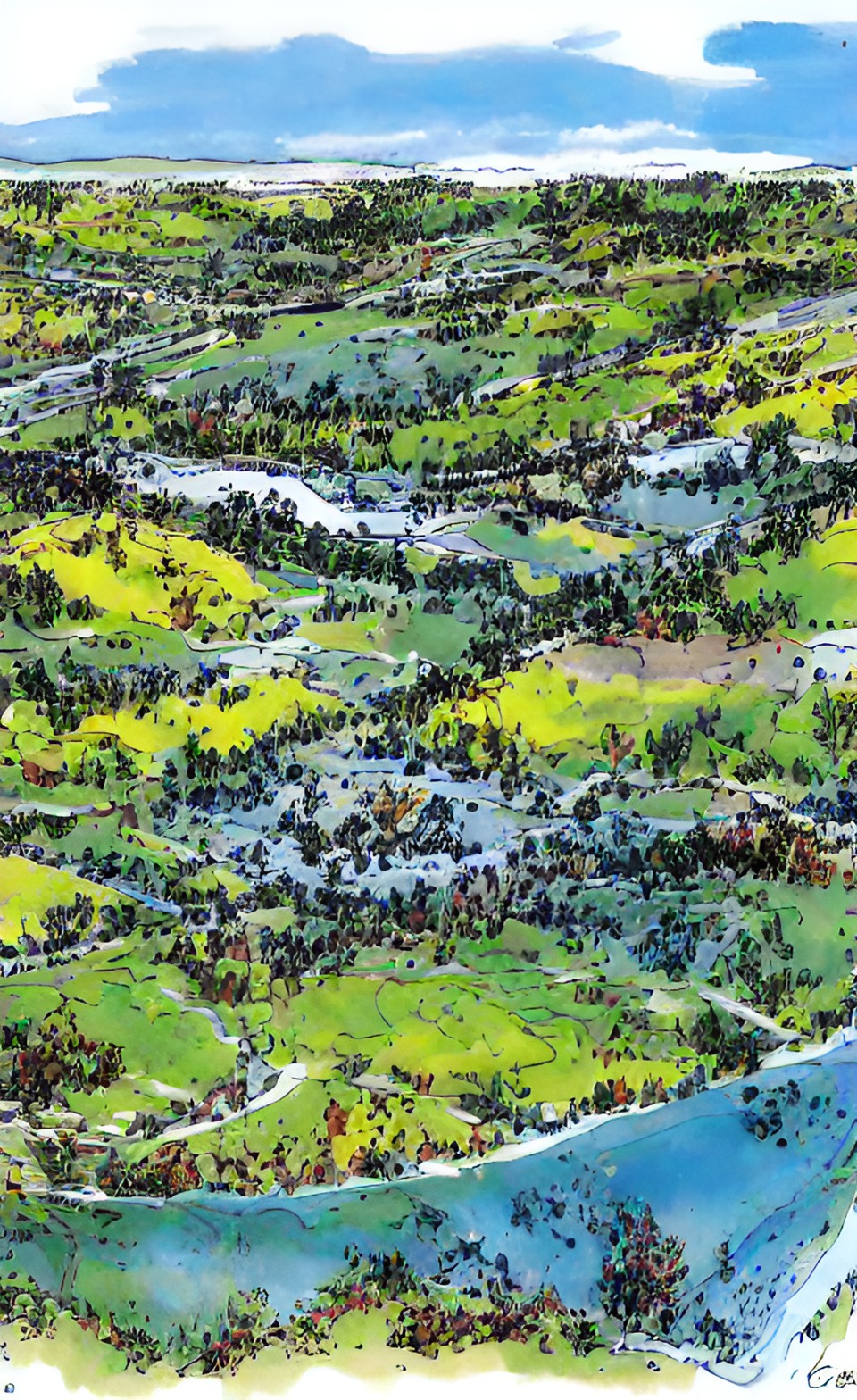- Air Homepage
- Alberta Air Quality
- Ambient Air Monitoring Equipment
- How to Measure Air Quality
Fresh air: revolutionizing how to measure air quality
A peculiar spectacle unfolds in Alberta, where the rugged Canadian Rockies meet the endless plains. Here, you might want to know how to measure air quality. Why? So that each breath you take, every exhale, is scrutinized, analyzed, and transformed into a wealth of knowledge.
Mother Nature meets Big Data, where air isn't just oxygen, nitrogen and other cryptic elements, it's a living record, an ever-changing story, a mystery. Here, we look deep into our ethereal landscape, where technology, regulation, and environmental stewardship blend together in a thing called air quality monitoring.
This monitoring is outlined in a document called the Air Monitoring Directive (AMD), which has nine chapters. The third section of Chapter 4 is covered in this article. Here's the first part of Chapter 4.
Section 4, covering mobile air quality monitoring is provided in short form here.
The entire chapter can be seen in its official form here.
Overview of 3 - Integrated Sampling
Here's a way to collect data on gases, vapors, and particles in the air. It's like taking a picture of the air. A lab analyzes these samples to figure out how much of a particular substance is in the air. There are different ways to do integrated sampling, like passive samplers, intermittent samplers, and static samplers.
 Typical Albertan countryside showing our clean air
Typical Albertan countryside showing our clean airIt depends on what you're measuring how long it takes to collect these samples. It could be a 24-hour sample every six days, a sample for a month, or even a quick "grab" sample. Shorter samples might catch short spikes in pollution, while longer ones help us see long-term trends. Follow these rules to make sure everything's done right:
- Unless the Director says it's not suitable, use available sampling equipment.
- Make sure you follow Standard Operating Procedures (SOPs) for each sampler you use. Describe how to set up, use, and maintain the equipment.
- If the SOPs conflict with the manufacturer's instructions, follow the Chapter's rules, unless the Director says otherwise.
- Keep track of how you collect, handle, and transport samples. Make sure samples aren't exposed to direct sunlight, prevent contamination, and keep them in good storage conditions.
- A chain of custody form should be attached to every sample. When the sample gets shipped to the lab, this form goes with it.
- Make a field sheet for every sample you take. Don't forget to include where you took the sample, when you started and stopped, and when it was shipped.
- Keep a 24-hour clock and use Mountain Standard Time.
- Labs that analyze your samples should meet certain criteria, like using ISO standards and properly documenting their methods.
- Labs should use quality flags to indicate the quality of results, especially if there's a problem with the sample or if the substance being analyzed is very small.
It's important to follow these rules so air quality data is accurate and reliable. Air quality helps us know if the air we breathe is safe.
3.1 Passive Sampling
Using passive sampling, a simple way how to measure air quality, you can figure out how much gas or vapor is in the air. It's passive because it doesn't need electricity or moving parts. It's great for places that are far away or hard to get to. Pollutants like sulfur dioxide, hydrogen sulfide, nitrogen dioxide, ozone, or volatile organic compounds (VOCs) can be detected with passive sampling.
These samplers let us see how pollution levels change over time and in different places. You're taking snapshots of the air to study its quality. You can find more info about passive sampling in the Appendix, and general guidelines in clauses ME 3-A to ME 3-L.
3.1.1 Passive Sampler Validation
Passive sampler validation is like making sure a tool works before you use it. Here, the tool is a passive sampler, which helps us measure the amount of certain gases in the air over time. Different factors can affect this measurement, like the type of sampler, weather conditions, and how we calculate the sampling rate. Different samplers might perform differently.
 One way to measure air quality is through passive sampling.
One way to measure air quality is through passive sampling.We validate passive samplers to see how accurate and precise they are. It's like making sure your ruler is measuring inches correctly. To do this, we test the sampler in the field and sometimes in a controlled lab setting. It should be done by someone other than the person using the sampler. We don't need to validate a sampler again unless something changes, like the sampler itself or how it's used.
To validate a passive sampler, we need to expose it to different levels of gases, for different durations, and under different weather conditions. It needs to be validated for at least a year if we want to use it in a place with changing seasons. To make sure the passive sampler's measurements are accurate, we compare them with a reference method.
We'll get a better idea of how well the passive sampler works the more validation tests we do. In the Appendix, you'll find more details.
3.1.2 Installation
You need to follow these rules when installing passive samplers as part of how to measure air quality:
- Make sure you read the AMD's Site Selection Chapter and the manufacturer's installation instructions.
- Make sure the passive sampler is positioned right.
- Make sure the sampler's diffusion barrier stays dry, dust-free, and protected from strong winds. It'll make sure the sampler works.
- Using a shelter to protect the sampler won't slow down its ability to pick up gases and won't make it too hot.
Follow these steps to get accurate air quality measurements. Shelter design can affect sampler performance. More details are in the manufacturer's recommendations.
3.1.3 Quality Control Samples for Field Sampling
It's important to maintain quality control when using passive samplers to measure air quality. Follow these steps:
- Use method blanks: Deploy at least one method blank during each sampling period, and the number should be at least 10% of the passive samples deployed. During sampling, method blanks help identify contamination sources.
- Using method blanks as passive samples: Deploy method blanks over the same period as passive samples, and handle them the same way, except don't expose the diffusion barrier surface to air.
- During each sampling period, deploy at least one replicate passive sample, which represents at least 10% of the passive samples deployed.
- At least one passive sample should be deployed with a reference method monitor whenever you have at least one reference method monitor and at least five passive sampling sites.
- Results comparison: Compare the time-weighted average pollutant concentrations from replicate passive samples with the corresponding passive samples and from co-located passive samples with the reference method monitor's average pollutant concentrations.
You can improve the precision and accuracy of your passive sampling results by following these steps and getting more quality control samples. You'll get reliable air quality data this way.
3.1.4 Sampling Period
Passive air quality sampling needs a long sampling period for accurate results. Here's how it works:
- When you collect air samples is important. Regulations usually set it or the Director authorizes it. Data accuracy depends on keeping the sampling period close to the prescribed one.
- You should deploy the sampler for 30 days (plus or minus 4 days) if you're doing monthly sampling.
- When sampling other than monthly, the sampler should be deployed within 10% of the specified time, unless the Director approves a different schedule.
Make sure the passive sampler is validated for the specific sampling period.
3.1.5 Determination of the Time-Weighted Average Pollutant Concentration
The average pollutant concentration in passive air samples depends on the sampling period, the mass collected, and the sampling rate. Here's how it breaks down:
- Passive samplers work through diffusion instead of active air pumps. They have to figure out how fast they collect pollutants (sampling rate). You can use Fick's law, laboratory tests, meteorological data, or integrative techniques to do this.
- As per the manufacturer's instructions, the person in charge (usually an environmental scientist) must calculate the average pollutant concentration for passive samples, replicate samples, and method blanks.
- If meteorological data is involved (which it often is), use the most representative weather information. By using this data, we can adjust the results for local conditions.
- Records: Keep records of the mass collected by the sampler, and if meteorological data is used, note where it came from. They're an essential component of how to measure air quality for tracking and reevaluating pollutant concentrations.
In a nutshell, determining average pollution levels in passive samples involves factors like time, mass, and how pollutants move through the air. Data and calculations need to be accurate.
3.2 How to measure air quality with Intermittent Sampling
Using intermittent sampling, you can check for dust, chemicals, and metals in the air. It's like taking a picture of the air. You can use them for a day every few days or even just a minute.
It's important to choose the right equipment and follow the manufacturer's instructions carefully, especially when it comes to things like temperature, air pressure, and the speed at which air is sucked in.
If you use a pump to collect air, make sure it works steadily. Imagine a camera taking pictures at the same speed for a set amount of time. Results won't be accurate if the pump goes too fast or too slow.
Before you start, make sure all the equipment is in good shape. Make sure your "camera" captures the right amount of air!
 Analyze the air quality accurately
Analyze the air quality accurately3.2.1 Filtration Sampling
Filtration sampling is like using a vacuum to collect tiny particles. Particles can be dust, pollution, or even metal. How to measure air quality for these particles? There are different filters for different types of particles, like big ones (TSP), medium ones (PM10), or really small ones (PM2.5). It's like using different filters on your vacuum.
These machines have filters inside, like HiVol or Partisol samplers. Filters like these are essential to catch the right particles without letting air escape.
You need the right filter material, pore size (tiny holes in the filter), and filter size to make sure everything works. You wouldn't drain pasta with a tiny strainer, would you?
Also, make sure the air flows properly at the beginning and end of sampling. You'd make sure your vacuum cleaner doesn't clog up or lose suction.
Finally, make sure you write down important details like which filter you used and how much air the machine collected. You can keep track of everything you've "vacuumed" from the air.
3.2.2 Active Sorbent Sampling
Activated sorbent sampling catches certain chemicals in the air. Imagine using a sponge to absorb volatile organic compounds (VOCs) or other chemicals from the air. Just like picking the right sponge to clean up a mess, you need to choose the right sponge based on what you want to catch.
You pull air over the sorbent with a machine with a pump. Chemicals come from the air, and the sorbent soaks them up. Like a vacuum cleaner.
You might need a filter along with the sorbent. It's like a safety net, catching dust and particles so they don't mess up your chemical collection.
Keep the airflow steady, use the right sorbent, and record all the details, like which sorbent you used and how much air the machine sucked in. You'll be able to collect the chemicals accurately this way.
3.2.3 Canister Sampling
You canister sample by capturing air in a special container, like a vacuum-sealed bottle. This way of how to measure air quality is great for collecting specific chemicals, like VOCs (volatile organic compounds). Before use, the container is carefully prepared in a lab to ensure it won't react with the chemicals.
Air is captured by opening the canister and letting it fill with a vacuum. So it sucks in the air you want to analyze. When there's enough air inside, you close the container. To keep out unwanted particles, you'll need the right canister material and sometimes a filter.
Make sure the vacuum inside the canister stays the right level, and it shouldn't go too high or too low. You're controlling the pressure in the canister to get accurate results.
Make sure there are no leaks, which could let air out. Your sampling results can be affected by this. Make sure your air samples are accurate by keeping records.
3.3 Static Sampling
Static sampling is an older technique for how to measure air quality without moving parts or electricity. Once used to get basic pollution trends info, it's now considered outdated. Passive and intermittent sampling give better results than older methods.
In Alberta, static sampling has some rules and guidelines, but it's being phased out. Static sampling is only allowed with special permission.
For things like sulfur compounds, static sampling was used in places like oil and gas facilities. Static sampling has been replaced by newer methods, like passive sampling.
Dustfall, when dust particles settle down, was also collected. Often used in coal mines, it was a rough way to monitor dust in the air. However, it's not as accurate as newer methods that sample finer dust particles. There are better ways to do it now, but you can still use this older method if it's allowed.
Static sampling requires you to sample the air for a specific amount of time to make sure it's representative of the conditions you want to measure.
What to do next
Get cutting-edge air quality regulatory compliance services for understanding and managing air quality. Our experts in the Air Monitoring Directive (AMD) can walk you through the complexities of air quality monitoring, offering insight into integrated sampling techniques, passive sampling methods, and intermittent sampling technologies.
Calvin Consulting Group Ltd. might be able to help you with an Air Monitoring Directive (AMD) audit. The audit would make sure EPEA approval and AMD requirements are met. This audit report provides insights for improving air quality monitoring and reporting.
Calvin Consulting is well-equipped to assist you in meeting stringent regulatory requirements and improving your environmental management systems if you need environmental data quality assurance and reporting. Let us help you develop AMD Quality Assurance Plans and ensure compliance with the Alberta AMD.
At Calvin Consulting Group Ltd., we'll make sure the air near your facility is safe by using accurate and reliable air quality data. You can reach Barry here for more info.
Take the first step towards environmental stewardship and technological excellence that will help you establish the best way you measure and manage air quality in your vicinity. You and your neighbours deserve the best air for your breath.
Details of air quality monitoring, showing you how cutting-edge technology and precise measuring methods are used to keep Alberta's air clean and safe.
Introduce yourself to regulatory aspects plus equipment, performance standards and maintenance. You can then learn about the meticulous processes that gives us assurance the air we breathe is good. Whether you're an environmental advocate, a technician, or Joe Curious, this explanation of Alberta air monitoring just might catch your fancy.
Do you have concerns about air pollution in your area??
Perhaps modelling air pollution will provide the answers to your question.
That is what I do on a full-time basis. Find out if it is necessary for your project.
Have your Say...
on the StuffintheAir facebook page
Other topics listed in these guides:
The Stuff-in-the-Air Site Map
And,
Thank you to my research and writing assistants, ChatGPT and WordTune, as well as Wombo and others for the images.
GPT-4, OpenAI's large-scale language generation model (and others provided by Google and Meta), helped generate this text. As soon as draft language is generated, the author reviews, edits, and revises it to their own liking and is responsible for the content.



New! Comments
Do you like what you see here? Please let us know in the box below.